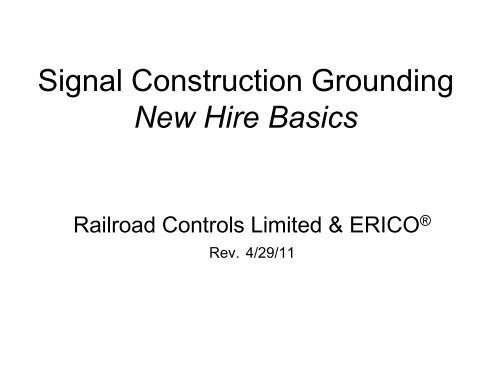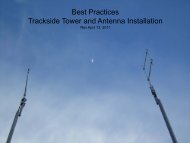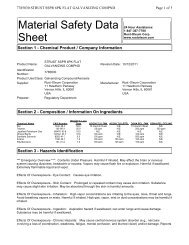Signal Construction Grounding New Hire Basics - Railroad Controls ...
Signal Construction Grounding New Hire Basics - Railroad Controls ...
Signal Construction Grounding New Hire Basics - Railroad Controls ...
You also want an ePaper? Increase the reach of your titles
YUMPU automatically turns print PDFs into web optimized ePapers that Google loves.
<strong>Signal</strong> <strong>Construction</strong> <strong>Grounding</strong><br />
<strong>New</strong> <strong>Hire</strong> <strong>Basics</strong><br />
<strong>Railroad</strong> <strong>Controls</strong> Limited & ERICO ®<br />
Rev. 4/29/11
Why is <strong>Grounding</strong> Important?<br />
• <strong>Grounding</strong> techniques applied in<br />
<strong>Railroad</strong> <strong>Signal</strong>ing address employee<br />
Safety & protect <strong>Signal</strong> Equipment<br />
from damage.<br />
• <strong>Railroad</strong>s deal with Electric,<br />
Electromagnetic, Electrostatic and<br />
even sunspot induced interference.<br />
• As a new hire, you will be installing<br />
important pieces of the grounding<br />
puzzle.
Lightning is Beautiful When There Isn’t a <strong>Railroad</strong> Track Around!
Extremely<br />
High Voltage<br />
The Killing Zone can extend<br />
several hundred yards from<br />
the lightning strike<br />
A characteristic lightning strike<br />
spreads radially from the point<br />
of strike with a typical<br />
frequency of 640hz. The<br />
voltage gradient through<br />
ground can be lethal due to the<br />
difference in voltage potential<br />
within only a couple of feet in<br />
this killing zone.<br />
Low<br />
Voltage
Extremely<br />
High Voltage<br />
(Windmill on the open prairie)<br />
It is not uncommon for cattle to be<br />
electrocuted standing on wet ground<br />
in the vicinity of a lightning strike. The<br />
voltage gradient is due to the fact the<br />
soil is not a perfect “ground”.
A small lightning strike was captured by a City of Roseville, CA<br />
intersection camera. The strike came into the top of the city light<br />
pole near the UPRR signal cantilever. RCL has an Automated<br />
Horn System installed here which happened to have a horn<br />
mounted on this same light pole. Although the AHS did not have<br />
any damage, one railroad grade crossing predictor did.
Surge Interference Potentials:<br />
line to line; line to ground, rail to rail, rail to<br />
ground; ground to ground, and basically<br />
between ground and/or between every<br />
signal circuit, structure or component we<br />
install or touch. MOO
DANGER<br />
DO NOT TOUCH SIGNAL<br />
CIRCUITS INSIDE OR<br />
OUTSIDE OF SIGNAL<br />
HOUSINGS DURING AN<br />
ELECTRICAL STORM!<br />
This is like playing<br />
Russian Roulette
Refer to BNSF Standard<br />
DK-0002.00:<br />
Each RCL crew will have<br />
available both a BNSF<br />
Standards & Recommended<br />
Practices Manual and a <strong>Signal</strong><br />
Instructions Manual.<br />
Let’s first discuss the ground<br />
rod and the exothermic ground<br />
rod connection.
Refer to BNSF Standard DK-<br />
0002:<br />
The 5/8” diameter, 5’ long Erico<br />
ground rods have a special<br />
thread-less coupler which is<br />
used to add additional rods<br />
when driving into the ground. A<br />
minimum depth of 10’ must be<br />
achieved.<br />
Ground rods are copper-plated<br />
steel rods.<br />
Note that these photos depict<br />
rods which are NOT yet properly<br />
cleaned for insertion.
Installing Ground Rods<br />
RCL uses the Eritech®<br />
Ground Rod Driver or an<br />
approved electric hammer<br />
driver to eliminate safety<br />
issues when installing<br />
ground rods.<br />
RCL does NOT allow the<br />
use of conventional fence<br />
post type drivers which<br />
expose us to personal<br />
injury.
Cadweld ® Products<br />
used on <strong>Railroad</strong>s ALL<br />
have the F80 weld<br />
metal powders which<br />
have the yellow caps.<br />
BNSF uses #6awg soft<br />
drawn copper for their<br />
external ground connections<br />
on signals & bungalows.
CADWELD ®<br />
ONE-SHOT Process
How Hot is the Cadweld?<br />
• The reaction in the crucible reaches temperatures in<br />
excess of 4000°F<br />
• The molten welding material is hot enough to exceed<br />
the melting point of steel when it reaches the rail (or<br />
ground rod), i.e. > 2750°F (ref. AISI C1020 steel).
Safety First<br />
• Always wear<br />
protective safety<br />
glasses and gloves<br />
while working with<br />
CADWELD<br />
exothermic products
NOTE:<br />
Yellow Cap<br />
Rail Applications<br />
One-Shot Materials<br />
• System requires a<br />
CADWELD One-<br />
Shot ceramic mold,<br />
welding material,<br />
wire brush for<br />
cleaning, flint igniter,<br />
and propane torch.
Inspect Ceramic Mold<br />
• Check to ensure<br />
ceramic mold is not<br />
broken or cracked<br />
which would cause<br />
leakage of molten<br />
weld metal during<br />
the reaction.
Torch Dry Conductors<br />
• Conductors should<br />
be clean and dry<br />
before the<br />
connection is made.<br />
Use a propane torch<br />
to dry conductor and<br />
ground rod.
Wire Brush Conductors<br />
• Use a wire brush to<br />
further prepare<br />
conductor.
Wire Brush Conductors<br />
• Use a wire brush to<br />
further prepare<br />
ground rod.
Twist Onto Rod<br />
• Gently turn the<br />
CADWELD One-<br />
Shot onto the<br />
ground rod until the<br />
ground rod reaches<br />
the stopper and<br />
cannot to any<br />
further.
Insert Conductors<br />
• Inset the conductors<br />
and position them<br />
for the connection.
Insert Conductors<br />
• Depending upon<br />
the type of oneshot<br />
used, insert<br />
wires into each<br />
whether used or<br />
not to ensure the<br />
weld metal is held<br />
in the weld.
Dish Side UP<br />
• Place the steel disk<br />
into the CADWELD<br />
One-Shot with the<br />
concave side facing<br />
up.
Proper Fit<br />
• Ensure that the steel<br />
disk is properly<br />
seated inside the<br />
CADWELD One-<br />
Shot mold. This<br />
forms the crucible<br />
for the reaction.
NOTE:<br />
Yellow Cap<br />
Rail Applications<br />
Blue Tube<br />
• Next, take the tube<br />
of welding material<br />
included in the<br />
CADWELD One-<br />
Shot package and<br />
remove the lid over<br />
the crucible.
Weld Material<br />
• Dump the loose<br />
welding material<br />
powder into the<br />
CADWELD One-<br />
Shot.
Mold Cover<br />
• Place the cover on<br />
the top of the<br />
CADWELD One-<br />
Shot.
Starting Material<br />
• The bottom of the<br />
weld material tube<br />
contains the<br />
compressed<br />
material (starting<br />
material). Tap tube<br />
to loosen.
Starting Material<br />
• Pour the starting<br />
material onto the<br />
CADWELD One-<br />
Shot cover.
Start the Reaction<br />
• Ignite the starting<br />
material on the mold<br />
cover. Withdraw the<br />
igniter quickly to<br />
prevent fouling of<br />
the flint.
Break Ceramic Mold<br />
• Break the ceramic<br />
CADWELD One-<br />
Shot mold off the<br />
connection. Avoid<br />
contact with hot<br />
materials.
Inspect Connection<br />
• See “Installers &<br />
Inspectors Guide” to<br />
see whether a<br />
quality connection<br />
has been made.
Successful Connection<br />
• You are ready to<br />
make another<br />
CADWELD One-<br />
Shot connection.
Need More Info?<br />
ERICO International<br />
1-800-447-RAIL<br />
http://www.erico.com
Erico Cadweld Welders:<br />
We will also use Cadweld Welders<br />
for splicing ground wires and for<br />
welding to ground rods, structures,<br />
and the rail. These have re-useable<br />
graphite molds.<br />
Always wear the appropriate<br />
personal protective equipment.
Erico Cadweld<br />
Exothermic Process:<br />
Here is a photo of a rail head<br />
bond being applied with rail<br />
head welders.<br />
Let’s talk about the safety<br />
concerns we see here:<br />
• Hinged crucible lids not in<br />
place.<br />
• Positioned on wrong side<br />
of the welder.<br />
• Sleeves rolled up.<br />
• Bonding tray could<br />
explode.<br />
• Goggles/face shield.<br />
• Hand on the rail.<br />
• Gasoline grinder.
Erico Cadweld<br />
Exothermic Process:<br />
Here is a photo of a One-<br />
Shot just applied on a<br />
ground rod.<br />
DANGER:<br />
NEVER ignite the crucible<br />
when ANY moisture is<br />
present on the rail, ground<br />
rod, in the mold, or if it is<br />
raining or snowing.<br />
An EXPLOSION will occur<br />
spraying hot molten brass<br />
at a temperature in excess<br />
of 2500°.
Refer to BNSF Standard<br />
DK-0002.00:<br />
<strong>Signal</strong> masts we will install are<br />
provided with a special<br />
aluminum to copper ground<br />
wire transition permanently<br />
attached to the mast.<br />
Although aluminum to copper<br />
connections have difficulty<br />
maintaining a good electrical<br />
connection due to oxidation,<br />
the aluminum sleeve is “spun”<br />
onto the copper at high speed<br />
and sealed providing an<br />
excellent connection.
Refer to BNSF Standard<br />
DK-0002:<br />
Ground rods will be installed<br />
outside of each of the four<br />
corners of a signal bungalow<br />
and two rods will be installed at<br />
a signal case.<br />
All of BNSF bungalows and<br />
cases have an aluminum to<br />
copper ground wire connection<br />
welded underneath the<br />
bungalow. These must be<br />
brought out and welded to the<br />
ground rods along with a<br />
#6awg counterpoise<br />
connecting all ground rods.
What is a Counterpoise?<br />
• A counterpoise is the<br />
ground wire connecting all<br />
the ground rods around<br />
the bungalow or case. This<br />
provides employee<br />
protection by keeping the<br />
ground potential just<br />
outside the bungalow the<br />
same as that of the<br />
bungalow itself. It also aids<br />
in dispersing ground<br />
currents from the<br />
bungalow.
• The counterpoise perimeter<br />
ground wiring should be<br />
installed a minimum of 12” from<br />
the perimeter of the bungalow<br />
or case and should be in soil<br />
approximately 4” to 6” under<br />
the ground level of the dress<br />
rock at the bungalow or case.<br />
Bungalow<br />
Frame <strong>Grounding</strong><br />
pigtails<br />
Counterpoise<br />
Ground Wire<br />
Ground<br />
Rods
Tower <strong>Grounding</strong> grid will<br />
be connected to the<br />
bungalow grounding grid.<br />
Intermediate ground rods<br />
will be installed every 10 ft.<br />
Refer to BNSF IS/Telecom<br />
Instructions.
If the tower ground<br />
were NOT connected<br />
to the bungalow<br />
ground grid,<br />
electrocution could<br />
occur if touching both<br />
the tower and the<br />
bungalow.
Make gradual, sweeping bends in ground conductors. When<br />
heavy ground current flows in a ground conductor, sharp<br />
bends act as a resistance to the magnetic field produced<br />
around the ground conductor by the surge current flowing to<br />
ground creating a huge difference of potential at the bend. This<br />
can elevate the voltage potential of our ground buss damaging<br />
equipment.<br />
Surge<br />
current<br />
flowing to<br />
ground<br />
Concentrated<br />
lines of flux which<br />
try to straighten<br />
the ground wire<br />
Extremely high<br />
difference of potential<br />
and smoked<br />
equipment<br />
Gradual<br />
bends can<br />
make a big<br />
difference
If an older bungalow is<br />
encountered which has the<br />
grounding pigtails on the<br />
terminal board frame, bring<br />
these through the hole in<br />
the floor directly below the<br />
pigtail and then weld them<br />
to the closest ground rods of<br />
the counterpoise.
Refer to BNSF Standard DK-0002 or your Supervisor for other<br />
important grounding information.
Refer to BNSF Standard<br />
DR-0014:<br />
To reduce surge current coupling<br />
into adjacent conductors, keep<br />
underground cable conductors a<br />
safe distance away from both<br />
grounding conductors & “Clean”<br />
bungalow wiring.<br />
If you have to run underground<br />
cable parallel to clean house<br />
wiring, maintain a distance greater<br />
than 8”. Crossings at 90° have<br />
little coupling effect to surge<br />
currents, however, maintain a<br />
minimum 8” distance whenever<br />
possible.
Induced<br />
Current<br />
Flux<br />
Field<br />
Builds<br />
Heavy<br />
Ground<br />
Current<br />
Refer to BNSF Standard DR-<br />
0014:<br />
As heavy current flows through<br />
any conductor, lines of flux<br />
build around the conductor. As<br />
these lines of flux cut across<br />
adjacent parallel conductors,<br />
current flow in the opposite<br />
direction will be induced in any<br />
adjacent conductor.<br />
The closer the adjacent<br />
conductor, the logarithmically<br />
greater the induced current.<br />
Therefore, maintain a minimum<br />
8” distance whenever possible.
Refer to BNSF Standard DR-<br />
0014:<br />
Underground cables leaving<br />
the bungalow en route to<br />
signals, switches and other<br />
signal enclosures will have the<br />
10mil bronze cable gopher<br />
shield grounded in the<br />
bungalow on only one end of<br />
the cable.<br />
(Refer to RCL Basic Cable<br />
Installation program for<br />
installation of this shield<br />
grounding connection.)
Refer to BNSF Standard<br />
DR-0014:<br />
Install cable and arresters as<br />
shown which provide for the<br />
following:<br />
• Underground cable conductor<br />
can be isolated by opening the<br />
gold test nut for megging tests.<br />
• The Lightning Arrester can be<br />
replaced WITHOUT<br />
disarranging the circuit.<br />
• The Equalizer can be replaced<br />
WITHOUT disarranging the<br />
circuit.
Refer to BNSF <strong>Signal</strong><br />
Instruction 14.1:<br />
When installing lightning<br />
arresters which have serrated<br />
teeth, orient them with the teeth<br />
pointed upward or horizontal.<br />
These teeth will melt away<br />
maintaining a ground free zone<br />
once the surge is dissipated.<br />
Otherwise, the molten slag can<br />
drip together and short the<br />
arrester to ground.<br />
BNSF will maintain ground<br />
rods at a minimum of 25Ω to<br />
ground.
There are many<br />
different types of<br />
lightning arresters and<br />
equalizers. Refer to the<br />
location circuit plan for<br />
proper application.<br />
Always install the<br />
arresters once the<br />
cable is terminated to<br />
protect the equipment.<br />
Legend:<br />
1<br />
2<br />
3<br />
2<br />
Heavy Duty Track Arrester – Safetran 022615-1X UP<br />
Heavy Duty Equalizer – Safetran 022700 -1X<br />
1<br />
1<br />
3<br />
To Track<br />
Clearview Lightning Arrester – Safetran 022485-28X UP<br />
To <strong>Signal</strong>,<br />
Switch, Electric<br />
Lock, or other<br />
B12 or B24<br />
circuit.
The arresters used on signal<br />
circuits are an “Air Gap” type.<br />
They are designed to maintain<br />
signal circuits free from ground<br />
while still doing their job.
Equalizer<br />
Clearview<br />
Lightning<br />
Arrester –<br />
Teeth UP
Each conductor<br />
entering a BNSF<br />
bungalow from the<br />
outside will be<br />
terminated and have a<br />
lightning arrestor,<br />
surge suppressor, or a<br />
combination of<br />
arrestor/equalizer at<br />
the entry point.<br />
There may easily be<br />
over 100 conductors<br />
to terminate and<br />
arrest.
Track wire terminations with Heavy Duty Lightening<br />
Arrestors & Equalizers with wires properly tagged.
GROUNDING REMINDERS<br />
• Make gradual, sweeping bends in<br />
ground conductors<br />
• Keep cable conductors greater than<br />
8” from grounding conductors or<br />
“clean” conductors when running<br />
parallel to each other.<br />
• Do NOT run grounding conductors<br />
within the same riser pipe as cables.<br />
• Weld all ground rod connections<br />
• Properly install all lightning & surge<br />
arresters to complete the process.
GROUNDING QUESTIONS?




